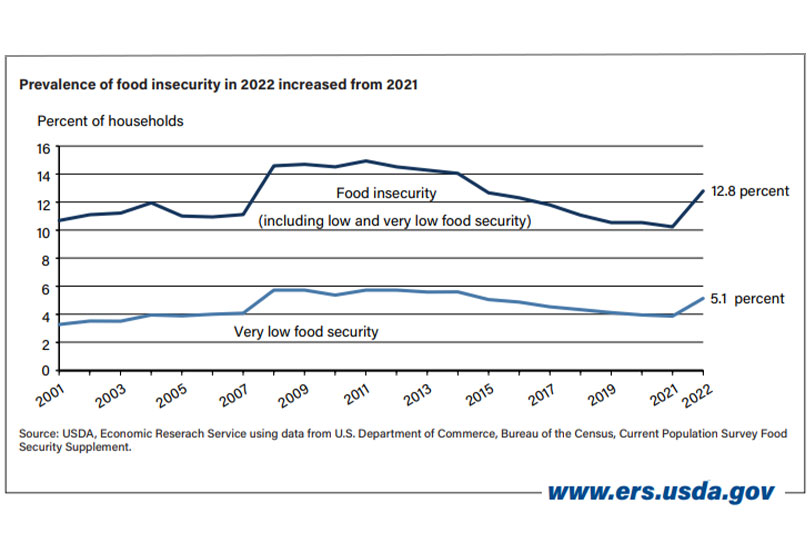By Shelby Shank
Field Editor
The number of food insecure households in the U.S. continued to climb in 2022, according to a recent U.S. Department of Agriculture (USDA) report.
Last year, about 12.8% of households were food insecure. That’s up from 10.2% the year prior and is the largest annual increase in USDA’s hunger measure since 2008.
USDA’s Household Food Security in the United States report revealed 2022 was the highest rate of food insecurity since 2014 when the rate was at 14%.
About 13.4 million kids in the U.S. lived in food insecure households in 2022.
The increase in food insecurity parallels with soaring food inflation. Grocery store prices climbed 11.4% in 2022, and the cost of eating at home has risen by an average of 2.5% over the past 20 years.
“These numbers are more than statistics,” U.S. Secretary of Agriculture Tom Vilsack said. “They paint a picture of just how many Americans faced the heartbreaking challenge last year of struggling to meet a basic need for themselves and their children, and the survey responses should be a wake-up call to those wanting to further roll back our anti-poverty and anti-hunger programs.”
USDA classifies a household or individual as food insecure if they had difficulties finding enough food at some point during the year. If households had to eat less or their eating patterns were disrupted during the year because they couldn’t afford enough food, they are considered to have very low food security.
Last year, 5.1% of households had very low food security, an increase of 3.8% from 2021.
An overwhelming 98% of those households that were considered very low food security last year reported they were worried food would run out. About 96% reported they could not afford to eat balanced meals, and the same percentage reported that, as an adult, they had to cut the size of a meal or skipped a meal.
About 29% of respondents reported that an adult in the household went an entire day without eating because there was not enough money for food.
Arkansas had the highest household food insecurity rate, averaging 16.6% from 2020 to 2022, followed by Texas at 15.5%. The U.S. average for the same period was 11.2%.
Over half of food insecure households in the survey reported that in the previous month, they participated in one or more of the three largest federal nutrition assistance programs: the Supplemental Nutrition Assistance Program; the Women, Infants, and Children nutrition program; and the National School Lunch Program.
“The uptick in food insecurity also occurred at a time when significant safety net enhancements that helped people through the worst of the pandemic began to end, including the expanded Child Tax Credit, universally free school meals, and, in a number of states, higher SNAP benefits,” Vilsack said.
To view USDA’s full report, click here.


Leave A Comment